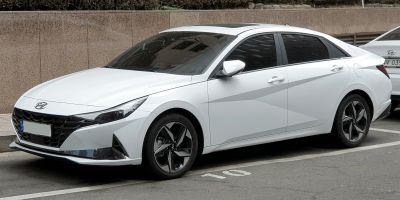Hyundai Elantra

- Year: 1990
- Status: in_production
- Also Called:
- Hyundai Avante
- Hyundai Lantra (1990–2000)
- Hyundai i30 Sedan (2020–present)
The Hyundai Elantra, also known as the Avante in South Korea, Singapore, and Russia, is a compact car produced by Hyundai since 1990. Initially marketed as the Lantra in Australia and some European markets to avoid confusion with similarly named models, the name was standardized globally as Elantra by 2001. The Elantra was launched to compete with Japanese compact cars and has evolved through multiple generations, now in its eighth generation, offering a range of body styles including sedan and coupe variants. Known for its practicality, value, and continuous improvements in design, technology, and safety, the Elantra has become one of Hyundai’s best-selling models worldwide. It features modern powertrains, including hybrid versions, and advanced safety and connectivity features, maintaining its position as a popular choice in the compact car segment.
Generations
First generation (J1; 1990)
The Hyundai Elantra's first generation (J1 platform, 1990-1995), launched Hyundai into the North American compact car market. Representing a significant leap for the Korean automaker, the J1 Elantra offered a surprisingly competitive combination of affordability, reliability, and fuel efficiency. Its design, while not particularly groundbreaking, was functional and inoffensive. While featuring a rather basic interior, the Elantra prioritized practicality over luxury, providing ample space for passengers and cargo. Available with a range of four-cylinder engines, it proved to be a surprisingly robust and economical vehicle, appealing primarily to budget-conscious buyers seeking reliable transportation. Its success laid the foundation for Hyundai’s subsequent growth and reputation in the global automotive industry.
Second generation (J2/RD; 1995)
Hyundai's second-generation Elantra (J2/RD platform, 1995-2000) built upon the success of its predecessor, enhancing both styling and features. The J2 Elantra adopted a more rounded and aerodynamic design, presenting a more modern aesthetic compared to its boxier predecessor. Interior improvements included upgraded materials and increased passenger space. Safety enhancements were also incorporated, reflecting the evolving industry standards. Engine options remained predominantly four-cylinder, with increased power and efficiency compared to the first generation. This model benefited from the ongoing improvement in Hyundai's overall build quality and reliability, further solidifying its position in the competitive compact car market. The Elantra J2 continued to demonstrate Hyundai's commitment to providing value and reliability.
Third generation (XD; 2000)
The Hyundai Elantra's third generation (XD platform, 2000-2006) marked a notable shift towards more sophisticated styling and features. The XD Elantra presented a more sculpted and aerodynamic design, aiming for a more upscale image. The interior experienced significant upgrades, with improved materials and a more refined dashboard layout. Hyundai continued to focus on practicality, providing ample passenger and cargo room. Engine options were refined for enhanced performance and fuel efficiency. The introduction of more advanced safety features like airbags and anti-lock brakes also highlighted Hyundai’s growing commitment to safety. This generation demonstrated Hyundai's growing maturity as a car manufacturer, showing a clear progression in design, features, and engineering quality.
Fourth generation (HD; 2006)
The Hyundai Elantra's fourth generation (HD platform, 2006-2010) further refined the formula established by its predecessors. Building on the design language of the XD generation, the HD Elantra showcased a sleeker and more modern aesthetic, emphasizing a more dynamic profile. Interior design focused on improving ergonomics and incorporating contemporary technology, with larger, more user-friendly infotainment systems becoming available. Engine choices reflected a continued focus on both performance and efficiency, with improvements in fuel economy and reduced emissions. Safety features continued to advance, with electronic stability control and more advanced airbag systems becoming increasingly standard across trims. This generation cemented the Elantra's reputation as a reliable, stylish, and well-equipped compact car, offering excellent value for the price.
Fifth generation (MD/UD/JK; 2010)
The Hyundai Elantra's fifth generation (MD/UD/JK, 2010-2015) marked a significant step forward for the model, moving beyond its somewhat bland predecessors. This generation boasted a more sculpted and aerodynamic design, featuring a bolder front grille and more expressive lines. Mechanically, it offered a range of four-cylinder engines, including a fuel-efficient option, paired with either manual or automatic transmissions. Safety features were improved compared to previous generations, with several models offering stability control and multiple airbags. While initially criticized by some for its ride quality on certain trims, the fifth-generation Elantra gained popularity due to its improved styling, increased fuel efficiency, and relatively competitive pricing, solidifying its position in the compact sedan segment. It also saw various trim levels and packages to cater to different buyer preferences.
Sixth generation (AD; 2015)
The Hyundai Elantra's sixth generation (AD, 2016-2020) represented a dramatic shift in design philosophy. This generation adopted a more fluidic sculpture design language, resulting in a sleeker and more sophisticated appearance than its predecessor. The interior saw a significant upgrade with higher-quality materials and a more ergonomic layout. Engine options were refined with a focus on fuel economy and performance, accompanied by improvements in transmission technology. Safety features were enhanced, incorporating advanced driver-assistance systems (ADAS) in higher trims, such as lane departure warnings and blind-spot monitoring. This generation also aimed for improved refinement and a more premium driving experience, successfully competing more effectively against established players in the compact car market. The platform was slightly more rigid leading to a more controlled ride and better handling.
Seventh generation (CN7; 2020)
The seventh-generation Hyundai Elantra (CN7, 2020-present) introduced a radical redesign, prioritizing a sporty and futuristic aesthetic. Its distinctive low-slung profile, sharp lines, and parametric grille set it apart from its predecessors and the competition. This generation offered a more sophisticated interior with an emphasis on technology, featuring larger infotainment screens and advanced connectivity features. Engine options included both naturally aspirated and turbocharged units, emphasizing both fuel efficiency and spirited performance. A significant focus was placed on safety, incorporating a comprehensive suite of ADAS features, including adaptive cruise control, automatic emergency braking, and lane-keeping assist, as standard or optional equipment across the trim levels. This generation elevated the Elantra's position as a technologically advanced and stylish compact sedan.